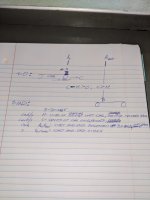ganutenator
Lifetime Supporting Member
I have a car traveling one direction, and a machine traveling the opposite direction.
The idea is to have the machine (bridge) travel at a rate to spend the most time possible on the car based off the length of the car but arrive at the end of travel at the right time.
This is the formula I have:
(*formula for calculating reverse bridge speed*)
(* (cnv_speed_inches / 60 * Bridge Travel Distance inches) / (car_length_inches + 28 inches(dist between pes) - Bridge Travel Distance inches) *)
It works in the field, but not in the shop.
The physics engineer found an error in the above formula and changed it to:
(*formula for calculating reverse bridge speed*)
(* (cnv_speed_inches / 60 * Bridge Travel Distance inches) / (car_length_inches + 28 inches(dist between pes) - cnv_speed_inches) *)
This new formula worked in the shop, but not in the field.
I'm perplexed.
In the shop, the car length could be incorrect. The engineer is convinced that the second formula is correct, but the first formula works. But I don't understand either.
The idea is to have the machine (bridge) travel at a rate to spend the most time possible on the car based off the length of the car but arrive at the end of travel at the right time.
This is the formula I have:
(*formula for calculating reverse bridge speed*)
(* (cnv_speed_inches / 60 * Bridge Travel Distance inches) / (car_length_inches + 28 inches(dist between pes) - Bridge Travel Distance inches) *)
It works in the field, but not in the shop.
The physics engineer found an error in the above formula and changed it to:
(*formula for calculating reverse bridge speed*)
(* (cnv_speed_inches / 60 * Bridge Travel Distance inches) / (car_length_inches + 28 inches(dist between pes) - cnv_speed_inches) *)
This new formula worked in the shop, but not in the field.
I'm perplexed.
In the shop, the car length could be incorrect. The engineer is convinced that the second formula is correct, but the first formula works. But I don't understand either.
Last edited:



